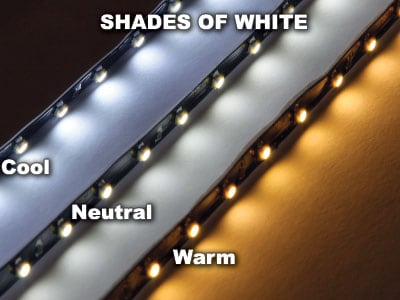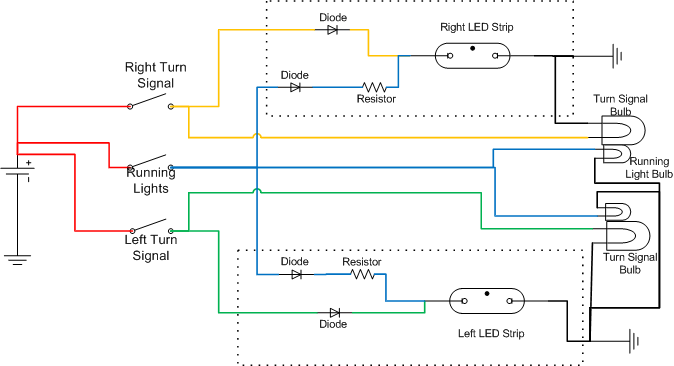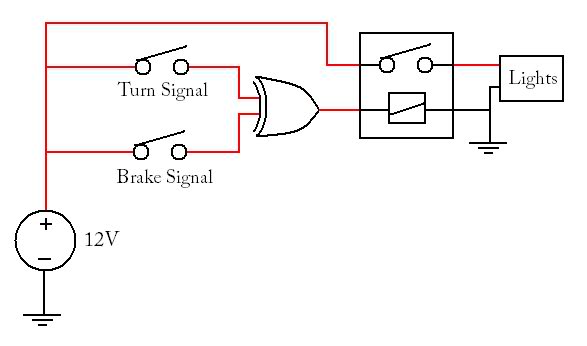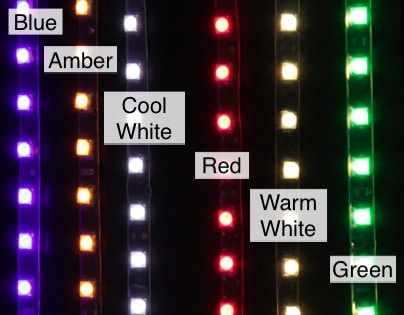Let’s say you were to add led strip lights to the sides of your vehicles because you wanted them to turn on when you put on your turn signals. It may seem like a mammoth task, but it is actually pretty simple, here’s how you’d do it:
- You would need 2 diodes and 1 resistor on each side. Dimming a LED using a resistor.
- The parking light wire needs to run through the diode, then through the resistor, and to the positive of your flexible led strip.
- Run the “turn signal” wire through the other diode to the positive of your led strip.
- Connect the negative of the led strip to the ground wire.
Read common questions and answers on flexible LED strip

Extra Information
mx107marlin
Alright…. I got you a diagram…
It looks complex for someone without much experience…. keep in mind you only need to be concerned with the parts within the dotted areas.
The colors are as follows:
Blue – Running lights
Green/Yellow – Turn Signal (Right/Left)
Black – Ground
I don’t know what the resistor value should be right now though… I don’t know enough about the LED strips. What length of strips do you want to use for each side.
EDIT: Just saw your post. Downside to the cold heat irons (I work at Radio Shack, we sell a bunch of them) is that the tips are made of graphite, which is very brittle. If you touch it the wrong way, the tip will break. If you have a Radio Shack near you, get either the 15/30 watt switchable iron, or one of the 45 watt irons. Get you some solder, and one of the cheap tool sets. That will make life easier.
Oh, and if you have a Radio Shack near you…. you can get most of your diodes, resistors, and other smaller things there… more complex IC’s and stuff like that will require ordering online.

PwrRngr
It’s a logic gate that will “filter” signals. Look into exclusive or gates (XOR Gate). Here’s a basic diagram.
From the code itself:
32-5-241. Auxiliary lamps
d) Special restriction on lamps.
Any lighted lamp or illuminated device upon a motor vehicle other than head lamps, spot lamps, auxiliary lamps or flashing front direction signals which projects a beam of light of an intensity greater than 300 candlepower shall be so directed that no part of the beam will strike the level of the roadway on which the vehicle stands at a distance of more than 75 feet from the vehicle.
No person shall drive or move any vehicle or equipment upon any highway with any lamp or device thereon displaying a red light visible from directly in front of the center thereof. This section shall not apply to authorized emergency vehicles.
Any vehicle may be equipped with flashing lamps which may be used for the purpose of warning the operators of other vehicles of the presence of a vehicular traffic hazard requiring the exercise of unusual care in approaching, overtaking or passing, and when so equipped may display such warning in addition to any other warning signals required by this section. The lamps used to display such warning to the front shall be mounted at the same level and as widely spaced laterally as practicable and shall display simultaneously flashing white or amber lights, or any shade of color between white and amber. The lamps used to display such warning to the rear shall be mounted at the same level and as widely spaced laterally as practicable, and shall show simultaneously flashing amber or red lights, or any shade of color between amber and red. These warning lights shall be visible from a distance of not less than 1,500 feet under normal atmospheric conditions at night.
Flashing lights may be used on motor vehicles as a means of indicating a right or left turn; a stop lamp may pulsate with different intensities provided that it meets at all intensities the provisions of subdivision (2) of subsection (b) of this section; and the warning lights on emergency vehicles may flash.


What kind of control module would I need to use to take led light strips that’s originally came with white DRLS and Amber turn signals to simply using only the Amber bulbs for DRL and signals